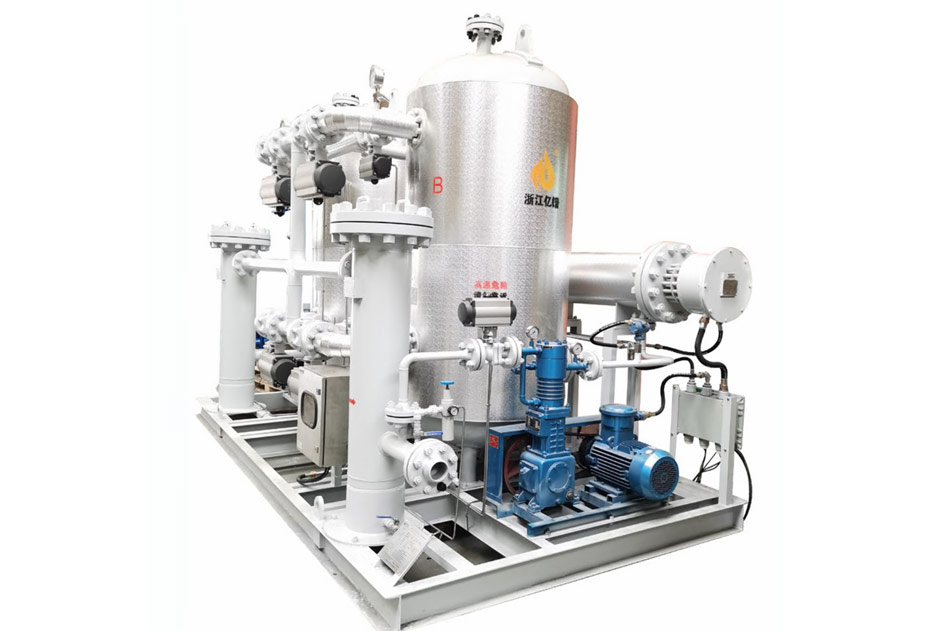High-Purity Nitrogen Purification Solutions for the Air Separation Industry
Industry Pain Points
Difficulty in Deep Removal of Trace Oxygen: Crude nitrogen from air separation contains 1-1000ppm oxygen. Traditional catalytic deoxygenation processes result in residual oxygen ≥0.1ppm, failing to meet the requirement for electronic-grade nitrogen (≤0.01ppm).
Hydrocarbon Contamination: CH₄/C₂H₆ (0.5-5ppm) produced by lubricating oil cracking poisons deoxygenation catalysts, shortening their service life from 5 years to 6-12 months.
Large Dew Point Fluctuations: Pressure changes (0.5-3MPa) in air separation columns reduce the dehydration efficiency of molecular sieves by 30%, causing the dew point of finished nitrogen to drift (-70℃→-40℃).
High Energy Consumption Costs: The power consumption of traditional purification systems (deoxygenation + dehydration) accounts for 15-20% of the total energy consumption of air separation, with annual operating costs exceeding 5 million yuan (for 10,000-class air separation).
System Overview
Through the “nano-catalysis – low-temperature adsorption – thermal coupling” technology loop, Yipu High-Purity Nitrogen Purification System achieves:
- Purity Leap: Breaks through the 0.005ppm residual oxygen limit, meeting the needs of 3nm chip manufacturing.
- Energy Consumption Revolution: The system’s net energy consumption is only 1/7 of that of traditional processes, reducing the comprehensive cost of air separation by 18%.
- Intelligent Protection: Full-life-cycle catalyst health management to avoid unplanned shutdowns.
Solution Approach
Yipu Air Separation Industry High-Purity Nitrogen Purification Solution
| Module | Technical Highlights | Performance Indicators |
|---|---|---|
| Nano Deoxygenation Tower | Pd/Al₂O₃ catalyst, honeycomb ceramic carrier | Outlet O₂ ≤0.005ppm, service life ≥5 years |
| Low-Temperature Adsorber | Stainless steel vacuum jacket, direct refrigerant cooling | Dew point -80℃@3MPa, fluctuation ≤±2℃ |
| Hydrocarbon Trap | Layered modified activated carbon + zeolite molecular sieve | CH₄ ≤0.01ppm, CO₂ ≤0.02ppm |
| Thermal Coupling System | Reaction heat recovery rate ≥90%, regeneration energy consumption 0.02kWh/Nm³ | No external heat source required |
| Intelligent Control | Laser oxygen analyzer + AI dynamic adjustment of catalyst temperature | Control accuracy ±0.5℃ |
Applicable Scenarios:
- Preparation of electronic-grade nitrogen (≥99.9999%)
- Ultra-high-purity nitrogen for aerospace
- Protective gas for stainless steel bright annealing
- Gas source for semiconductor packaging
Technical Principles
Yipu Four-Stage Ultra-Purity Purification Process:
- Deep Deoxygenation (Stage 1):Palladium-based nano-catalysts reduce O₂ to 0.005ppm at 200-250℃, increasing CH₄ poisoning resistance by 10 times.
- Low-Temperature Adsorption (Stage 2):Combined dehydration with -40℃ pre-cooling + 13X molecular sieves maintains a stable dew point of -80℃ (within ±0.5MPa pressure fluctuation).
- Hydrocarbon Removal (Stage 3):Activated carbon-zeolite composite bed adsorbs CH₄ to ≤0.01ppm, while simultaneously removing N₂O/CO₂.
- Self-Heating Regeneration (Stage 4):Uses deoxygenation reaction heat (ΔH=-285kJ/mol) to drive molecular sieve regeneration, saving 80% more energy than electric heating.
Core Advantage
| Advantage | Details |
|---|---|
| Customized on Demand | Meets special working conditions; provides professional non-standard customization |
| Low Cost | Adopts cyclic regeneration process; significantly reduces operating costs |
| High Stability | Dual-tower structure with small pressure fluctuation; low noise and continuous gas supply |
| Fully Automatic Operation | Easy to operate, reducing labor input; improves efficiency |
| High Safety | Presets multi-level safety protection measures; supports automatic alarm |
| Low Failure Rate | Maintains low failure rate after 10,000 hours; high durability with almost no maintenance required |
Technical Strength
Leading Adsorption Dehydration Technology
Uses high-performance molecular sieve adsorbents with high water absorption capacity and resistance to corrosion by acidic gases (H₂S/CO₂), ensuring deep dehydration with a dew point ≤-70℃.
The original hot nitrogen regeneration process reduces energy consumption by 30% compared with traditional electric heating regeneration, and integrates a waste heat recovery system to significantly improve energy efficiency.
Modular and Customized Design Capability
Core equipment adopts modular prefabrication, supporting rapid deployment (installation cycle shortened by 50%) and adapting to diverse scenarios such as offshore platforms, onshore gas fields, and LNG pretreatment.
Can customize single-tower, dual-tower, or multi-tower parallel systems according to customer needs, with a treatment capacity ranging from 10,000 to 1,000,000 Nm³/d, flexibly matching gas fields of different scales.
Intelligent Control and Remote Operation & Maintenance
Equipped with a PLC+IoT intelligent control system, it real-time monitors key parameters such as pressure, temperature, and dew point, supporting fault early warning and automatic adjustment.
Through cloud-based big data analysis, it optimizes the adsorption-regeneration cycle, extends the service life of molecular sieves, and reduces operation and maintenance (O&M) costs by 10%-15%.
Energy-Saving and Environmental Protection Technology
Features zero-emission design for regeneration exhaust gas, complying with international environmental standards such as EU CE and US EPA.
Energy consumption is 25%-40% lower than that of traditional triethylene glycol (TEG) dehydration systems, helping customers achieve carbon emission reduction goals.
Long-Cycle Operation Reliability
Molecular sieves adopt anti-pulverization coating technology, with a service life of over 5 years, reducing replacement frequency.
Key components (e.g., valves, instruments) are selected from international first-tier brands (e.g., Siemens, Emerson), with a Mean Time Between Failures (MTBF) of over 100,000 hours.
Strong R&D and Engineering Experience
Possesses more than 19 patents and software copyrights in dehydration technology; the R&D team is led by doctors and has in-depth cooperation with universities and colleges.
Has over 1,000 successful cases worldwide, covering extreme working conditions such as high-sulfur gas fields in the Middle East and low-temperature environments in the Arctic.
Product Advantage Comparison
| Indicator | Yipu System | Traditional Refrigeration Type | Competitor Adsorption Type | Membrane Separation Method |
|---|---|---|---|---|
| Residual Oxygen Content | ≤0.005ppm | ≥0.1ppm | ≥1ppm | ≥10ppm |
| Hydrocarbon Control | CH₄ ≤0.01ppm | Requires additional treatment | CH₄ ≤0.1ppm | No hydrocarbon removal capability |
| Dew Point Stability | -80℃±2℃ (0.3-3.5MPa) | -70℃±15℃ | -60℃±10℃ | -40℃±20℃ |
| Energy Consumption | 0.05kWh/Nm³ (comprehensive) | 0.3kWh/Nm³ | 0.15kWh/Nm³ | 0.08kWh/Nm³ |
| Catalyst Service Life | 5 years (CH₄ ≤5ppm) | 1 year (fails at CH₄ ≥1ppm) | Not applicable | Not applicable |
Typical Case
Project Name: A 30,000 Nm³/h Electronic-Grade Nitrogen Project for a Semiconductor Factory
Operating Conditions:
- Feed Nitrogen: O₂ 10ppm, CH₄ 2ppm, dew point -60℃
- Requirements: O₂ ≤0.01ppm, CH₄ ≤0.02ppm, dew point ≤-75℃
Effect:
- Outlet O₂: 0.003ppm, CH₄: 0.008ppm, dew point: -82℃
- Catalysts have been in operation for 4 years without replacement
Economic Benefits:
- Annual savings of 12 million yuan in electricity and catalyst costs
- Reduced wafer oxidation defect losses by 240 million yuan per year

